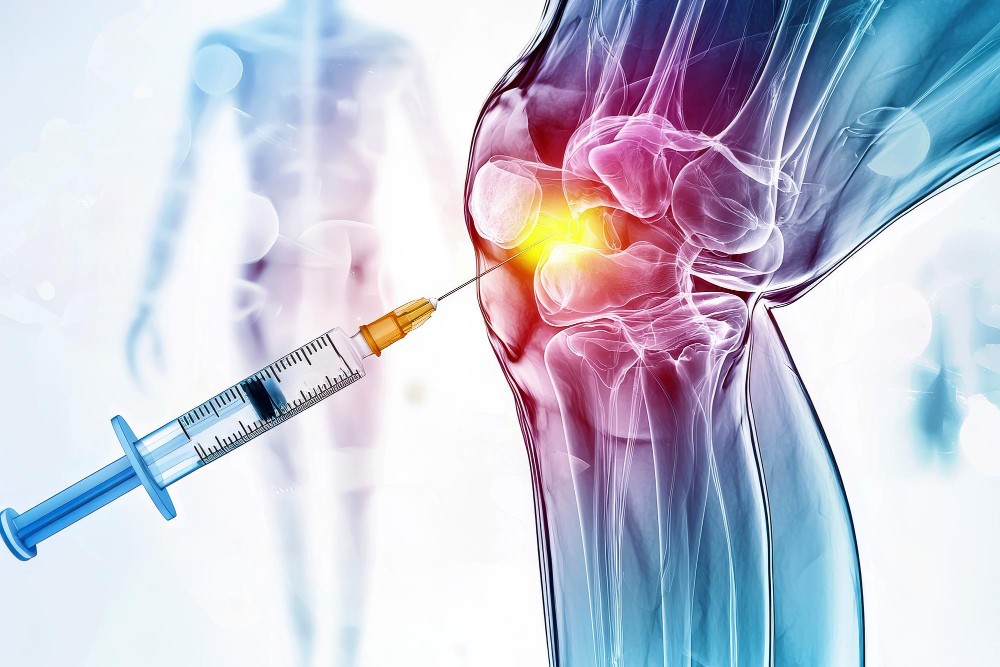WAS IST ARTHROSE?
- Arthrose ist die häufigste chronische Erkrankung des Knorpels. Wenn sich der Knorpel aufgrund von Abnutzung und/oder mechanischer Belastung abbaut, kommt es zu Schwellungen, Schmerzen und Entzündungen, die zu einem Verlust der extrazellulären Matrix (EZM) führen.¹
- Arthrose ist eine fortschreitende Gelenkerkrankung, die häufig intra- und periartikuläre Strukturen² betrifft und als Pathologie gilt, die durch Gelenkknorpelläsionen, Synovitis, subchondrale Sklerose und Osteophyten³ gekennzeichnet ist.
- Arthrose ist meist eine langsam fortschreitende Gelenkerkrankung, die durch Knorpeldegeneration und Entzündung gekennzeichnet ist⁴. Kniearthrose führt häufig zu Knieschmerzen und schränkt die Patienten in ihrer Mobilität ein.
- Die Schmerzen bei Arthrose stehen in der Regel im Zusammenhang mit körperlicher Aktivität. Bei Arthrose im Knie führen Aktivitäten wie Treppensteigen, Aufstehen und langes Gehen zu Schmerzen. Die Morgensteifheit hält in der Regel weniger als 30 Minuten an. Patienten bemerken oft, dass ihre Knie "nachgeben", ein so genanntes Instabilitätssymptom.
WAS SIND DIE RISIKOFAKTOREN FÜR ARTHROSE?
- Das Alter ist einer der größten Risikofaktoren 7
- Biologische altersbedingte Veränderungen in den Gelenkstrukturen 7
- Auslöser für Knie OA bei Frauen: Übergewicht 8 (Knie-OA) 8
- Frühere Knieverletzungen (Knie-OA) - Kniefehlstellung (Knie-OA) 9,10
- Schwäche der Kniestreckmuskulatur (Knie-OA) 11
- Nockendeformität und leichte Dysplasie (vor allem bei Personen mittleren Alters (55-65 Jahre), aber nicht bei der älteren Bevölkerung (über 65 Jahre)) (Hüft-OA) 12
- Schwere Dysplasie (Hüft-OA) (OA)= Osteoarthritis
WAS IST INTRA-ARTIKULAR INJEKTION?
Hyaluronsäure ist ein wichtiger Bestandteil der Gelenkflüssigkeit und des Knorpels und ist für die Schmierung und Unterstützung der Gelenke verantwortlich. Sie verringert die Reibung zwischen den Gelenkoberflächen und schützt das Weichgewebe vor Traumata, indem sie als Stoßdämpfer wirkt.
Hyaluronsäure wirkt außerdem schmerzlindernd, entzündungshemmend und antioxidativ, stimuliert die Proteoglykansynthese und erleichtert den Abtransport von Knorpeltrümmern.
Diese hochwertige Hyaluronsäure wird auf Grundlage des Europäischen Arzneibuchs hergestellt.
Mit unserer Marke Welux vereinen wir diese Vorteile in Form einer Spritze für mehr Lebensqualität.
VERWEISE
- R. Altman, E. Asch, D. Bloch, G. Bole, D. Borenstein, K. Brandt, W. Christy, T.D. Cooke, R. Greenwald, M. Hochberg, et al., Development of criteria for the classification and reporting of osteoarthritis. Classification of osteoarthritis of the knee, Diagn. Ther. Crit. Commit. Am. Rheum. Assoc. Arthritis Rheum. 29 (8) (1986) 1039–1049.
- Lane NE, Brandt K, Hawker G, et al. OARSI-FDA initiative: Defining the disease state of osteoarthritis. Osteoarthritis Cartilage 2011;19(5):478–82.
- Su K, Bai Y, Wang J, et al. Comparison of hyaluronic acid and PRP intra-articular injection with combined intra-articular and intraosseous PRP injections to treat patients with knee osteoarthritis. Clin Rheumatol 2018;37(5):1341–50.
- Cheng OT, Souzdalnitski D, Vrooman B, Cheng J. Evidence-Based Knee Injections for theManagement of Arthritis. Pain Med (United States). 2012;13(6):740-753.
- Guccione A, Felson D, Anderson J et al. The effects of specific medical conditions on the functional limitations of elders in the Framingham Study. American Journal of Public Health. 1994;84(3):351-358.
- Altman R, Asch E, Bloch D, et al. Development of criteria for the classification and reporting of osteoarthritis. Arthritis Rheum 1986;29:1039-49.
- Zhang Y, Jordan JM. Epidemiology of osteoarthritis. Rheum Dis Clin North Am 2008; 34: 515–29.
- Silverwood V, Blagojevic-Bucknall M, Jinks C, Jordan JL, Protheroe J, Jordan KP. Current evidence on risk factors for knee osteoarthritis in older adults: a systematic review and meta analysis. Osteoarthritis Cartilage 2015; 23: 507–15.
- Brouwer GM, van Tol AW, Bergink AP, et al. Association between valgus and varus alignment and the development and progressio of radiographic osteoarthritis of the knee. Arthritis Rheum 2007; 56: 1204–11.
- Runhaar J, van Middelkoop M, Reijman M, Vroegindeweij D, Oei EH, Bierma-Zeinstra SM. Malalignment: a possible target for prevention of incident knee osteoarthritis in overweight and obese women. Rheumatology (Oxford) 2014; 53: 1618–24.
- Oiestad BE, Juhl CB, Eitzen I, Thorlund JB. Knee extensor muscle weakness is a risk factor for development of knee osteoarthritis. A systematic review and meta-analysis. Osteoarthritis Cartilage 2015;23: 171–77.
- Gala L, Clohisy JC, Beaulé PE. Hip dysplasia in the young adult Bone Joint Surg Am 2016; 98: 63–73.
- Hunter, David J et al. “The symptoms of osteoarthritis and the genesis of pain.” Rheumatic diseases clinics of North America vol. 34,3 (2008): 623-43. doi:10.1016/j.rdc.2008.05.004
- (M. Hemshekhar, R.M. Thushara, S. Chandranayaka, L.S. Sherman, K. Kemparaju, K.S. Girish, Emerging roles of hyaluronic acid bio scaffolds in tissue engineering and regenerative medicine, Int. J. Biol. Macromol. 86 (2016) 917– 928. doi:10.1016/j.ijbiomac.2016.02.032.)
- Altman RD, Bedi A, Karlsson J, Sancheti P, Schemitsch E. Product Differences in Intraarticular Hyaluronic Acids for Osteoarthritis of the Knee. Am J Sports Med. 2015.
- Pereira H, Sousa DA, Cunha A, Andrade R, Espregueira-Mendes J, Oliveira JM, Reis RL. Hyaluronic Acid. Adv Exp Med Biol. 2018;1059:137-153. doi: 10.1007/978-3-319-76735- 2_6. PMID: 29736572.
 English
English
 Deutsch
Deutsch


